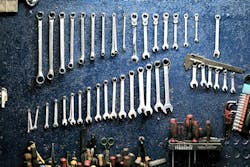Five years ago, when Mercedes-Benz of Fort Mitchell (Ky.) was being designed, dealership leaders tore up the blueprints roughly 20 times. They sought a dealership layout that was nothing short of awe inspiring.
Lo and behold, on the day of the facility’s grand opening in October 2013, a Mercedes-Benz official was on site raving about the dealership’s aesthetics.
“They were very, very pleased with the way the layout was, and the way that the [customer] flow was,” recalls Don Paparella, managing partner. “I think, quite frankly, we were a model of what Mercedes really likes and aspires to have at their dealerships.”
These days, the 55,000-square-foot, suburban Cincinnati facility boasts a sterling CSI score of 96 percent, thanks in large part to an appealing lobby that caters to all customers—regardless of whether they stopped in for sales, service, or parts.
Of the $20 million that was spent on building Mercedes-Benz of Fort Mitchell, roughly 10 percent of it was devoted to the lobby area. And that, Paparella says, has proven to be money well spent.
“It’s worth every penny,” he says. “The lobby is integral, because it’s a main stopover for the client.”
Paparella describes how to optimize lobby space so that it serves all fixed operations customers.
Optimize the customer experience.
We wanted to do that from when you pulled onto the lot to when you got out of your car, to when you sat and got coffee. So, we looked at a lot of different dealerships and went to the NADA show to look at different things. Mercedes had an exterior and finishes that were a requirement, so they told us how they wanted the outside of the building to look, and then the finishes on the interior, and after that it’s up to us to make sure that the flow goes correctly. It was probably 45 days of getting the lobby just the way we wanted it; we ended up designing it to make the client flow and the client interaction pretty seamless.
Get a creative architect.
We had a wonderful architect that would sketch it for us, then we would make changes and he’d sketch it out again. We were working on how to get the flow so that the client comes in and it’s very apparent from the signage where you should go. We tried to make it with easy sightlines, inviting finishes, and openness. We tried to have it very open, so that everyone can kind of see where to go.
Create an open feel.
People nowadays like an open feel. From the service write-up area, everyone can see the waiting room. The center of the waiting area is where our service receptionists sit, so when people come in, they’re funnelled right to them. We also have an “Answer Bar”—we shamelessly borrowed that name from Apple—where we have one or two product concierges sit; their job is to answer any questions that the client might have. Then, our boutique is integrated into that, so that, while people are there, they’ll see nice shirts and mugs and hats to buy.
Keep things comfortable.
We’ve got comfortable chairs, LED lights everywhere. We have a 50-inch TV. We have free WiFi, of course. So, we’ll have people come in, get their car washed and use our WiFi, grab a pastry. We have coffee from our local coffee shop, a cooler with sodas, juices. Then, one of the things we actually just opened up is a “nail bar” for our clients that wait. So, we literally have a nail bar staffed with anywhere from 1–3 nail technicians, and it’s a complimentary manicure.
Set it up so you value customers’ time.
We know that the biggest thing our clients want out of every day is time. We set things up in the lobby to value their time. You know, I’ve got self-serve pastries, and we try to do a car wash in 15 minutes, so we don’t waste their time. When you come into the service drive area, I have service drive personnel that greet you right away. Then, they’ll either bring you to an advisor, or to a waiting room. We try to value their time to the best of our ability.
Create an inviting atmosphere.
A lobby has to be a place where a client would like to spend time. And it has to have clear, easy sightlines, so people can see right where they want to go—they can see coffee, they can see the TV, they can see the service receptionist, they can see the advisors. We like an open floor plan because of that. We also have a large—probably 15 feet tall by 20 feet wide—window to our service department, and we obviously keep our service department clean, so that our clients that want to wait can actually watch their cars being worked on. We tried to make it inviting. It has to be inviting.





